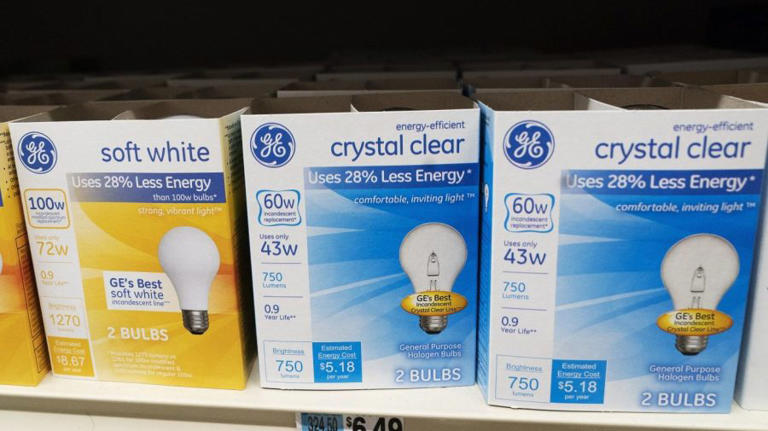The Hill
<?XML:NAMESPACE PREFIX = "[default] http://www.w3.org/2000/svg" NS = "http://www.w3.org/2000/svg" />Follow
LED lightbulbs may be hazardous to your health
Opinion by Katherine Drabiak, opinion contributor•1h
LED lightbulbs may be hazardous to your health© Provided by The Hill
The Department of Energy recently announced that it will enforce new rules that prohibit the manufacture and sale of certain types of incandescent and halogen lightbulbs used in homes. Stores can continue selling already stocked merchandise but will face stiff penalties for noncompliance.
The Energy Policy and Conservation Act gives the Energy Department authority to regulate the energy efficiency of consumer products. New standards must further environmental protection and advance public health. The department asserts that this rule modernizes energy efficiency, slashes carbon emissions, and will reduce energy costs. LED bulbs are an estimated 90 percent more energy efficient, and often touted as more economically and environmentally responsible.
Disagreement over how to regulate certain lightbulbs has been brewing for years. In 2019, the Department of Energy determined that it did not need to modify energy conservation standards for certain lightbulbs. In 2021, President Biden issued an executive order that directed federal agencies to review recent policies that were “inconsistent” with reducing carbon and greenhouse gas emissions. Agency decisions, said Biden, must “listen to the science” and protect public health and the environment.The Energy Department interpreted this to mean issuing new restrictive rules, which became effective in July 2022. During the rulemaking process, multiple groups expressed concerns over adverse environmental impacts from forcing adoption of LEDs as the primary light source in our homes. The department flatly rejected these concern, claiming that it had not found any evidence that using LEDs in daily life directly results in adverse health effects or negatively affects animals.
This claim stands in stark contrast to decades of existing science on blue light, LEDs, and potential detrimental impacts to both human and environmental health. To compare, in 2019 the French Agency of Food, Environmental, and Occupational Health and Safety published a detailed report summarizing research on LEDs. It documented public health concerns such as flicker, phototoxicity, glare and impact to human circadian rhythms.
Related video: 'Huge game changer': New rules about which light bulbs can be sold, manufactured take effect Tuesday (WXMI Grand Rapids, MI)
what kinds of bulbs can be manufactured and sold are
So yes, there is at least some evidence of negative impact, whether or not it constitutes proof. And it might not be your imagination if LED lights induce a sense of discomfort, feel blinding to you, or emit what seems to you like a bizarre glow.LED bulbs differ from other lightbulbs in spectral composition. They emit brighter, bluer light in shorter wavelengths, into a smaller emission area. They also rapidly flicker on and off, which is referred to as temporal light modulation. For most people, this flickering is not consciously perceptible. But our brains notice it, which can result in headaches, eye strain, eye fatigue and decreased visual performance — without even realizing that these symptoms could be connected to the LED light near us.
Some research suggests that exposure to the blue light found in LEDs is phototoxic and can induce damage in retinal cells, which can lead to vision problems, speed up aging of our eyes and lead to macular degeneration.
Light should allow our eyes to see visual images clearly. But LEDs can produce glare, which makes it more difficult for our eyes to see the objects around us, causing things to look blurry. Trying to refocus our eyes can cause discomfort and eye fatigue.
LEDs are all around us — from overhead lighting, to table lamps, to the backlighting on tablets and phones. Even a small amount of blue light from these sources in the evening can inhibit melatonin production and disrupt our circadian rhythm. Thousands of articles have examined the effect of light on circadian rhythm. LED exposure can delay or prevent us from falling asleep, and degrades the quality of our sleep.
The Energy Department’s rule also ignores other environmental impacts of LEDs. They contribute to greater light pollution, which negatively affects bird navigation, sea-turtle mating and the survival of beneficial insects that rely on nighttime darkness. Compared to compact fluorescent bulbs, LEDs are mercury free, but they do contain arsenic and lead, which researchers suggest carry a higher toxicity potential. LEDs also cause significantly more natural resource depletion than incandescent bulbs, leading some scientists to assert that we should reconsider labeling them as environmentally friendly.
This rule is not simply updating “outdated and wasteful technology,” but rather a decision that reflects a narrow focus on reducing energy consumption while disregarding the full scope of potential public health concerns. The Energy Department should consider revising the rule accordingly.
Katherine Drabiak is a professor of health law, public health law and medical ethics in the College of Public Health at the University of South Florida.
Above is from: LED lightbulbs may be hazardous to your health (msn.com)


No comments:
Post a Comment